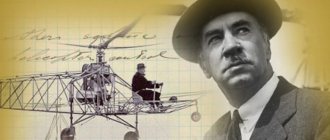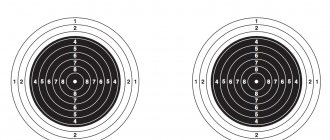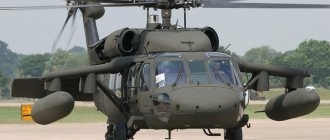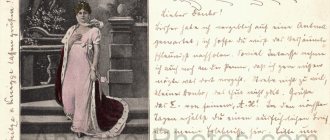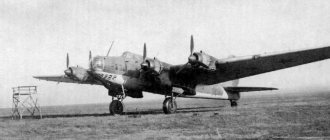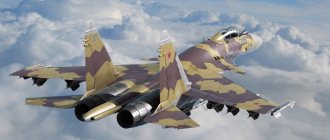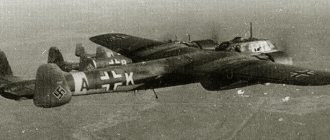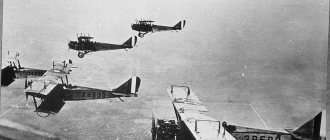Sikorsky, man and helicopter
In his second – “American” – life, Igor Ivanovich Sikorsky fell in love with mountaineering.
He especially loved climbing volcanoes. This would be the time to speculate that this hobby reminded him of his own destiny: up, down, up again, to the abyss, which is about to spew out fire... He himself believes that he made the first big mistake in his life , succumbing to his father’s persuasion and went to study in the naval cadet corps, following his older brother. For some reason, this decision seemed right to the sickly boy from land-based Kyiv, who loved all kinds of mechanisms. Actually, everyone makes mistakes in life, but what is important is not the mistakes themselves, but the ability to understand them and respond to them.
Sikorsky responded three years later: he left the cadet corps with a fully formed goal - he wanted to become an engineer. Which already says a lot about the character of our hero - after all, the vast majority of people, having made a similar mistake (in their studies, profession or personal life), live their whole lives with it, cursing their unfortunate fate and disgusting changeable fortune...
The BiS-1 aircraft (Bylinkin and Sikorsky) is the first development of Igor Sikorsky, with co-author.
Things didn’t go well with studies right away - in Russia that year, students weren’t particularly interested in studying, the reaction of 1907 was raging, and Igor’s father decided that his youngest son should study in Paris for now. And in Paris - about happiness! - he ends up at the Duvignau de Lanno school, where almost everyone around him was literally an aviation fan and dreamed of flying. Actually, our hero easily and with great pleasure became “infected” with this passion, becoming close to one of the very first (and successful) aircraft manufacturers in Europe - the Frenchman Farber, after communicating with whom Sikorsky had a mountain of notes.
Six months later, he returns to Kyiv, enters the Polytechnic Institute, where he is again lucky with teachers - here both Zhukovsky’s student Artemyev and the famous mathematician Delaunay - Sikorsky becomes a member of the aeronautics club they created.
The star of the circle at that time was Fyodor Bylinkin, who became famous for creating an exact copy of the Wright brothers' plane: it was beautiful, but it didn't fly. Which did not at all detract from Bylinkin’s authority in the eyes of his comrades.
In 1908, Igor and his father went to Germany, and all of Germany was talking only about the brilliant Wright brothers (they were on a “tour” in Europe). Impressed, Sikorsky, rethinking what he had read and seen, creates his first model of a helicopter, right on the table in his hotel room - alas, the car does not take off.
Wright Brothers Biplane.
Returning to Kyiv, he demonstrates remarkable business skills by finding an investor: his sister Olga is ready to sponsor the development of a helicopter. As a result, its development takes off from the ground, but is not able to withstand the weight of a person; there is not enough engine power.
And Sikorsky switches to airplanes, spending most of his time in the student circle mentioned above. The students and teachers did not have enough knowledge - and there was nowhere to get it from, but they were overflowing with enthusiasm.
In 1910, Bylinkin, Sikorsky and Vasily Jordan, an irreplaceable jack of all trades, created their first airplane - BIS-1, named after the first letters of the authors' surnames. Alas, again there is not enough engine power, and the plane, like Bylinkin’s creation, remains on the ground. Bitter disappointment, but Sikorsky knows how to work on mistakes, and his second plane, created in 1910, BIS-2, flies!
C5a, a fairly advanced aircraft model for its time, on which Sikorsky set a number of world records.
And how it flies, almost no worse than the miracle of the Wright brothers - it flew 600 meters and stayed in the air for 42 seconds. It must be said that this brilliant achievement was preceded by a series of falls and breakdowns, but Sikorsky not only survived, but also “taught” his plane to fly.
He will receive his pilot's diploma only a year later, without much distraction from creating new, more advanced models. His S-5 amazes even the emperor, who sees its flight during maneuvers and honors the designer with an audience. The S-5 already maneuvers at an altitude of about 500 meters, its flight range is 82 km, and its speed is 125 km/h.
The first flight already seems to Sikorsky himself to be a distant past, although a little more than a year has passed since its date... On his S-6, Sikorsky is already breaking world records, but the complex competitive tests, which, according to his recollections, cost the young man incredible nerves, he does not always win - a narrow then the world of aviators is filled with rumors about the machinations of competitors, bribes, sabotage...
General Shidlovsky driving one of the top models of the Russo-Balt car.
In 1911, he met the chairman of the board of directors of the RBVZ (Russian-Baltic Repair Plant, based in Riga, but already had a branch in St. Petersburg), General Shidlovsky, and he offered the 23-year-old Sikorsky the position of chief engineer of the Russo-Balt aviation department.
By that time, Russo-Balt was already gaining modest experience in aircraft manufacturing, producing a small number of Farmans and Newports under license. The ideas of Shidlovsky and Sikorsky are incredible: they plan to create a multi-engine giant aircraft with a closed cockpit. The intensive work of 1912-1914 culminated in the release of two models: the “Russian Knight” and a more advanced aircraft that brought its creator world fame – the “Ilya Muromets”.
At the same time, the name of Sikorsky becomes the subject of obstruction - no, Igor Sikorsky is the glory and pride of the country, his “Ilya Muromets”, which amazed his contemporaries (almost 100 copies of it will be released) stuns the imagination, but here’s the story with his dad...
Sikorsky was often reproached for being at work all the time and not resting at all. This is, of course, not true. Here he was, rested, the snowmobile he made is evidence of this. You can get back to business.
Our hero’s father is modestly mentioned, as a rule, as a “famous Russian psychiatrist” (which is true: in any case, Ivan Sikorsky created several clinics for the mentally ill and wrote a number of scientific works), but they do not mention him as a very active Black Hundreds. This second “I” of his broke out when he was called as an expert to court in the famous “Beilis case,” which Sikorsky Sr. presented as a bloody ritual murder.
His “evidence” was so empty and so obviously far-fetched that the scientific world subsequently regarded him as a swindler. However, the reaction of science is one thing, but in other segments of the population his “evidence” fell on a completely different ground: mass Jewish pogroms began throughout the country, the obvious cause and guilt of which was precisely the “expert psychiatrist” Sikorsky.
According to contemporaries, Igor Sikorsky experienced this extremely painfully; General Shidlovsky even had to speak publicly in defense of the young man. A certain scar in the soul of Igor Sikorsky, however, will remain: he will consider the just indignation against his father to be biased and in the future he will emphasize throughout his life that he wants to deal only with Russians and Orthodox Christians, although harsh criticism of the unprofessional was not at all due to religious and national motives. his father's behavior.
The giant “Ilya Muromets”: this design was said to be ahead of its time. This is true, but it was precisely these ideas that, for various reasons, received their development then.
The First World War begins, Sikorsky's planes dominate the air, but there is no particular use for them: it seems that everyone understood that the plane was an effective means of bombing, but the mechanisms for this, and even the air bombs themselves, did not yet exist. Brusilov, one of the best commanders of that war, spoke of airplanes as completely useless pieces of iron, which were expensive to maintain, and there was no point in them. As a rule, the pilot threw a grenade out of the cockpit, which sometimes exploded before reaching the ground.
Nevertheless, more far-sighted military men understood the prospects of aerial bombing, and Russo-Balt was very active in producing and developing new ideas. The revolution began, life at the Russo-Balt plant was fading, although it was still glimmering, but, as they say, the clouds were gathering...
In 1919, Sikorsky is saved not by a Russian or an Orthodox Christian: one of the workers of his factory, a Finn, warns Sikorsky that his arrest is being prepared. Sikorsky knows how arrests usually end at that time (his friend and patron Shidlovsky has already been captured): he flees through Murmansk to Paris, where he tries to find a use for himself.
Paris, 1917, Russian emigration. “Gentlemen, everyone is in Paris...” However, not only gentlemen...
Alas, the timing is very unfortunate: the recognized genius of aircraft construction finds himself in a time period when the war is already over and there is no longer a demand for bombers, but civil aviation does not yet exist, and there is still no demand for large aircraft. He is making an excellent development in France (“an aircraft capable of dropping a bomb weighing a ton”) - but the aircraft does not go into production, military tasks are no longer paramount. Sikorsky, in the hope of finding a job, moves to New York, but, alas, things are no better here. His attempts to get a job as an aircraft designer with the US government last a long time, but do not end in anything, and Sikorsky makes a living by teaching mathematics and astronomy and... there is a complete feeling that that’s all with the aircraft industry... An end to his engineering career.
Probably, for some, such a collapse could be a point, but not for Sikorsky, for whom ups and downs are his normal life cycle.
New York, '20 last century.
In 1923, Sikorsky created the Sikorsky Aero Engineering Corporation. The company has no funds at all, Russian emigrants invited by Sikorsky work for free, the place of work is a former chicken coop, rather shaky and leaky, parts for the first aircraft are bought at sales or (more often) collected, literally, from garbage dumps (one of the participants in those events recalls , that they marked many components as “temporary” because they were assembled from inappropriate material), and the main money for the construction of the aircraft was collected among the emigration by subscription, and these were more than modest donations.
One day it occurs to Sikorsky to talk with Rachmaninov, the famous composer and pianist. He buys an incredibly expensive concert ticket (I think $20, Rachmaninov is incredibly highly valued) and dreams that the composer will donate two hundred hundred to his cause... That would be a miracle and the ultimate dream!
As a result, they were able to meet (which is a miracle in itself) and actually got along: Sergei Vasilyevich invested an incredible $5,000 and even accepted the title of vice president of the company (incredibly beneficial from an advertising point of view). The business of the newborn aircraft concern immediately took off...
Looking ahead, let's say that years later Sikorsky paid off with Rachmaninov in full, paying both the amount itself and large interest on it (it is known that Rachmaninov did not set such conditions).
Rachmaninov (center) and Sikorsky (right) near the S-29 transport aircraft.
In 1924, Sikorsky released the S-29A biplane (oh, everything is not easy either: it falls and almost turns into a pile of garbage on its first flight, but Sikorsky brings it to mind), which serves him for a long time and “feeds” him, transporting cargo, the whole company. This plane, having served its life, dies heroically: Hollywood buys it to film the downed plane. The year 1926 brings new problems and misfortunes: the S-35 plane, specially created by Sikorsky for the flight New York - Paris, crashes, the pilot and mechanic miraculously survive. And again a miracle: the surviving pilot (Rene Fonck - once again neither Russian nor Orthodox helps out) finds the money to finance a new plane. He, unlike the newspapermen who attacked Sikorsky, understands how good this model is, and understands that the incident that almost cost him his life was an accident. Alas, Fonck never became the first pilot to cross the Atlantic: Charles Lindbergh preceded him in 1927, and Fonck's collaboration with Sikorsky ended.
Charles Lindbergh, who became an incredibly popular person and a worldwide hero. Sikorsky had a philosophical attitude towards his success: yes, he crossed the path of his project, but he did much more to popularize aviation, and therefore Sikorsky’s work, than others.
However, this pushed Sikorsky to create amphibious aircraft, where he ultimately succeeded extraordinarily. In 1928, he released the S-38 model, which is unconditionally recognized as the best in its class. The small enterprise received orders from the US Department of Defense and Pan America, from Canada and South America, from Europe, moreover, several aircraft ended up in the Soviet Union (one of them is shown in the film “Volga-Volga”). And all this - in quantities that a small plant is not able to produce. Sikorsky builds a new large plant in Bridgeport, increases staff, organizes absolutely wonderful production (it is described as exemplary), but the Great Depression ruins all plans.
Orders are melting away, customers are running away, previously ordered aircraft are not being sold... It would seem that there is a collapse again, but, as we already see, Sikorsky is not only a brilliant engineer, he is also an excellent manager - realizing that otherwise what has been done cannot be saved, he negotiates the sale of his company (it was called at that moment Sikorsky Aviation) United Aircraft airline.
Passengers take their seats in the S-40.
As a result, his plant was saved from ruin, and Sikorsky’s personal financial situation became stable - he could continue to do what he loved, there were funds for this.
His customer is Pan America, which liked Sikorsky’s planes so much, he produces more and more new models that set many world records: in flight range, in weight moved, in speed (his planes by that time were already reaching speeds of more than 300 km/h ), but the world is especially amazed by his S-42 Clipper, created in 1934, which flew from America to New Zealand. In the mid-30s, when the demand for aircraft improved and, it would seem, Sikorsky would again be in demand, a scandal broke out with one of the Sikorsky models and his competitors. Aviation historians believe that United Aircraft behaved strangely and even stupidly in this story, as they would say now, “stupidly merging.” As a result, Sikorsky himself found himself in a secondary role in the company and no longer took part in its affairs. Disappointment? Of course, what else! In the end, so many ideas, so many plans have not been realized.
Probably, for the vast majority of people this could be a reason for sadness and depression, but certainly not for Sikorsky.
Sikorsky aircraft on a United Aircraft advertising poster.
On the contrary, this is where the work begins, which, in the end, immortalized the name of the already brilliant inventor - the history of helicopter construction begins. Actually, even without a helicopter, Sikorsky would have secured a name for himself in history as a great aircraft designer, but resting on his laurels is not at all in his character. However, it seems that the topic of creating a device, which he began to assemble on the table of a Wiesbaden hotel in 1908, never left him, and his forced removal from the “airplane topic” had a beneficial effect on this idea of his: he received time, and a small resource in terms of human and mechanical he had. In addition, for some time there was no rush factor, which had so poisoned Sikorsky’s entire life earlier. The management of United Aircraft agreed to “bring in” their disgraced aircraft designer, giving the green light to his new project, but not really counting on the result. Sikorsky’s first development, called VS-300, “learned to fly” for several years.
The first model of a Sikorsky helicopter (with the inventor at the controls) takes off from the ground.
The model flew perfectly back and forth and did not want to move forward, which caused a lot of jokes even in the military department, which was very friendly to Sikorsky. But Sikorsky is Sikorsky - in just a year he redesigned his helicopter model 18 (!!!) times: about once every 20 days, and his helicopter flew.
The first helicopter, which went down in history as the XR-4 (this was the code name for this model, in “civilian” language - VS-316) took off in mid-January 1942. The military tested it on their own and were quite pleased with the result. 130 of these helicopters were produced, which took part in both military and rescue operations during the war.
In addition, quite a large number of helicopters (of the next generation) were ordered by the armies of Britain and Canada. But not only armies needed a helicopter: Sikorsky’s next model, the S-51, was purchased by civilian departments, rescuers and the post office. In the world of aircraft manufacturing, Sikorsky’s developments also created a sensation, and his success sharply increased competition in this segment. Convinced that a helicopter is necessary, important and possible, many companies are rushing into this segment.
Frank Piasecki, a man who has something to be proud of in his life. The rivalry between Sikorsky and Pyasetsky led to a real explosion of ideas in helicopter engineering.
However, Sikorsky suffers his only “defeat” in procurement competitions from his American compatriot, an aircraft designer of Polish origin, the brilliant Frank Piasecki (Sikorsky’s first model is only a few months ahead of the Pole’s development): in 1946, the US Army chooses Piasecki’s helicopter for purchase from -for its better ergonomics and compactness. The defeat was severe, even economically: missing out on such an order would put an end to subsequent developments, which should have fueled revenues from the sale of previous models. This led to another conflict between Sikorsky and the management of United Aircraft, but... defeats always only provoked Sikorsky, and he had something to answer his competitor.
Handsome S-56. With some changes it still works today.
He decisively moved towards the creation of powerful helicopters: his S-55 lifted a ton of weight, and the S-56 already five tons - Pyasetsky lost the segment of heavy helicopters, the demand for which Sikorsky was so successfully able to foresee, followed by the middle class, where reigned model S-58. In 1957, Sikorsky retired (remaining a consultant in his company until the end of his life).
He led a rather stormy social life, heading various kinds of associations of Russians in America - the Tolstoyan and Pushkin societies, contributed to the construction of the Orthodox Church, became interested in philosophy and theology, and even wrote a couple of books on this topic in English, as he dreamed of introducing people to his deeds and thoughts. the maximum number of people around him, but he never completely left the development of new machines and mechanisms.
Igor Ivanovich Sikorsky was never without work in his life.
His fame is so great to this day that in the mass consciousness (and in not very conscientious publications) his name is fixed as the “inventor of the helicopter,” which, of course, is not true.
The path from naked and unsupported youthful enthusiasm to the heights of success, the path of ups and downs, glory and despair - this man drank it all. One may be surprised at this, or one may consider this to be a normal and ordinary path for any creator.
Author: Alexander Ivanov
VPS server hosting with fast NVMe disks and daily payment. Upload your ISO.
The Allies were confident of victory over Germany
Such a high status of the participants testified to the exceptional importance of the conference, convened to develop a general plan of military action against the Quadruple Alliance, as well as resolve diplomatic issues related to future changes in the political map of the world.
Reference
On the Russian side, the conference was attended by ministers of foreign affairs, military, maritime, finance, trade and industry, as well as the manager of the Ministry of Railways. Representatives of the army and navy - Inspector General of Artillery under the Supreme Commander-in-Chief, Grand Duke Sergei Mikhailovich, acting. (i.d.) Chief of Staff of the Supreme Commander-in-Chief, Cavalry General V.I. Gurko, Chief of the Naval Staff under the Supreme Commander-in-Chief Admiral A.I. Rusin, as well as members of the State Council - S.D. Sazonov and A.A. Neratov. Foreign Minister Pokrovsky presided, and the management of the affairs of the conference was entrusted to Comrade Minister of Finance S.A. Chatelain.
© RGAKFD.
Participants in the conference of the Entente countries in Petrograd, 1917. As noted in the documents, the heads of the allied delegations “unanimously pointed out the need to establish complete unity of action between the allies in order to bring the war to a successful end and end it in peace, but not on such terms as the allies are forced to would submit, but on conditions that they themselves would authoritatively present to the enemy.”
There was no doubt about the victory of the Entente, although a lot of effort was still required to achieve it. In this sense, it is appropriate to draw a parallel with the Tehran Conference of 1943, when Germany’s defeat became obvious, but the enemy delayed surrender until May 1945.
A detailed study of the Petrograd Conference will take at least several monographs, so in the article I will focus only on one particular, but, nevertheless, very eloquent point.
First designs
Already in the summer of 1908, student Sikorsky began to develop and build his first helicopter. The work was carried out in the courtyard of his father’s estate and in the KPI aviation garage. Igor is acutely aware of the lack of engine power required. In January 1909, he went to Paris to get acquainted with experience in this area and purchase an engine. His father should be given credit: he understands that the business his youngest son has taken up is not a temporary hobby, so he not only helps him with money, but also blesses him for further work. A letter of recommendation to one of the most famous aviators of that time, Ferdinand Ferber, was given to him by KPI professor, author of the designs of the first domestic gliders, Nikolai Delaunay. It was Ferber who became Sikorsky's first flight instructor and consultant in the selection of the necessary materials and equipment. After three months in France, Igor Sikorsky returned home not only with new knowledge and literature, but most importantly, with a twenty-five-horsepower Anzani engine for his helicopter.
Unfortunately, the first helicopter was never able to take off. However, his tests helped to discover many features that need to be paid attention to when designing such devices. Taking into account the test results and visiting Paris again, in the spring of 1910, Igor Sikorsky created his second helicopter. But he couldn’t take off either. It was not a matter of mistakes and errors of the developer, but the lack of an engine of the required weight and power. The young designer understood this and, in parallel with the helicopter, began to develop his first airplane. Together with his institute friend Fyodor Bylinkin, he led a team of like-minded people. Young enthusiasts organized aircraft workshops in two specially built hangars in KPI and Kurenevka. Their classmates, students, became voluntary assistants to the aircraft designers. Workers were also hired for the work - tinsmiths, carpenters, mechanics. The result of the joint work of Bylinkin, Sikorsky and another polytechnician Vasily Jordan were the BiS-1 and BiS-2 aircraft. Among the products of the workshop of Bylinkin and Sikorsky were snowmobiles of their own design, which in 1909 caused delight among the people of Kiev at a sports festival at the Pechersk hippodrome. After some time, Bylinkin retired from active design work, and the workshops came under the complete control of I. Sikorsky. It was here that his machines were built, which were already flying confidently: S-3, S-4, S-5 and the record holder S-6.
The construction of the latter was preceded by the first aerodynamic experiments, which Sikorsky conducted on a homemade installation. Their results were taken into account when designing and manufacturing a gondola for the pilot with passengers, landing gear, gas tanks and a radiator, which, together with the use of a powerful 100-horsepower Argus engine, allowed Sikorsky to break the world speed record on December 29, 1909 - 111 km/h. Sikorsky piloted his airplanes himself. The next development of the young designer, the S-6A, was also awarded records.
Based on the fundamental basic and deep engineering knowledge acquired at KPI, Igor Sikorsky consistently developed his own theory of constructing aircraft. It was based on an original method of preliminary calculation of the flight qualities of a future machine. This allowed the designer to determine in advance, in general, all the main qualities and characteristics of the airplane - its horizontal and vertical speeds, take-off time and range, and the like. The airplanes created by Sikorsky in Kyiv confirmed in practice the correctness of his approach, calculations and graphical constructions.
In April 1912, the S-6A aircraft was shown at the Moscow Aeronautics Exhibition, where it received a Grand Gold Medal. The Russian Technical Society awarded I. Sikorsky a medal “for useful work in aeronautics and for the independent development of an airplane of his own system, which gave remarkable results.”
How the first Russian bomber was lifted into the sky
The production of power plants for the Ilya Muromets began in Russia during the war. In order to completely solve the “engine issue,” the creation of a large aircraft engine plant in Rybinsk began.
In 1916, the leadership of our country decided to develop an aviation scientific-industrial complex near Kherson. It was planned to build two serial plants (engines and aircraft) and one pilot plant for the implementation of new projects. A university and aviation school, a special airfield for experimental aircraft, and a laboratory with a wind tunnel capable of studying life-size aircraft were also to begin operating there.
© wikipedia.org
Near the plane with a training 25-pound bomb. In the center are Kireev, Nikolsky, Sikorsky, Pankratiev (with a tablet in his hand), Shidlovsky.
Reference
In 1916, the Russian-Baltic Motor Plant was created in Petrograd, two aircraft manufacturing plants were built in Yaroslavl, another one in Taganrog, Aviapribor in Moscow, and the RBVZ plant in Fili. This is not the entire list of enterprises that were supposed to produce products in the near future.
Alas, two revolutions - February and October - had an extremely negative impact on this successfully progressing project, as, in fact, on the aircraft industry as a whole.
Chaos in the economy, the collapse of the front, and the Civil War slowed down the development of Russian aviation for a long time.
Confession
Having not completed his studies at the institute, 23-year-old Sikorsky comes to St. Petersburg at the invitation of the Russian-Baltic Wagon Works (RBVZ).
In addition, Sikorsky receives the position of chief engineer of the naval aviation being established. In the capital, he is completely immersed in aircraft construction.
During his work at RBVZ, new innovative aircraft were produced one after another: seaplanes, training models, biplanes and monoplanes.
Sikorsky aircraft participated in international exhibitions, won prizes and were sold to foreign countries. He received great support from the Chairman of the RBVZ, M.V. Shildovsky.
Models S-10 and S-12 began to be produced and delivered to the front and navy. The S-10 reconnaissance aircraft occupied the main place in the armament of the navy at the beginning of the First World War.
Between 1912 and 1914, the twin-engine Grand aircraft, the first of its kind in the world, was created; it was followed by the modification “Russian Knight” - already a four-engine aircraft.
The plane became the forefather of all heavy aircraft construction. Nikolai 2 himself wanted to inspect it and climbed into the cabin along with Sikorsky. For his services, the tsar awarded the young aircraft designer a personalized watch.
Family
The Sikorsky family was well known in Kyiv. First of all, thanks to my father, Ivan Alekseevich, an outstanding psychiatrist, whose scientific works have not lost their significance to this day. Doctor of Medicine, member of scientific societies in several countries, for many years head of the department at St. Vladimir’s Kiev University, founder and editor of the journal “Issues of Neuropsychiatric Medicine and Psychology”, he also managed to be actively involved in social activities. He took part in the spiritual and religious life of Kyiv, since, as the son and grandson of Orthodox priests, he graduated from a theological school and seminary. The talented artist Viktor Vasnetsov immortalized the features of Ivan Sikorsky in the paintings of the Vladimir Cathedral, choosing him as a model for the image of St. John the Baptist.
Igor Sikorsky was born on June 6 (May 25, New Style) 1889. His mother, Maria Stefanovna, played an important role in his life. She was a highly educated woman, but she devoted her life to her family, which, besides Igor, had four more children. Thanks to her, a special comfort and creative atmosphere reigned in the Sikorsky house, which is so necessary for the harmonious development of extraordinary personalities. The childhood years of the future aircraft designer were illuminated by the light of culture, art and deep knowledge about the world around him, which his family gave him and which determined his entire future destiny.
The creation of the giant “Ilya Muromets”
While still a student, Sikorsky became infected with the idea of creating a giant aircraft. In those days, such reasoning was not taken seriously and seemed fantastic.
As time passed, due to the successful launch of the Vityaz, at the end of 1913, the 19-meter Ilya Muromets S-22, which he dreamed of as a child, appeared.
Until 1917, this aircraft was considered the largest in the world.
In the spring of 1914, it was redesigned (floats attached) into a seaplane. The second model of the aircraft made a breakthrough, lifting ten passengers to a height of 2000 meters and transporting them along the St. Petersburg-Kyiv route and back.
In the era of the birth of aviation, when an active race of aircraft designers was going on all over the world and records were changing one after another, in Russia “Ilya Muromets” had no equal until 1923.
Since 1915, “Ilya Muromets” went into mass production. During the war years, the country received over 80 heavy airliners of various modifications.
Russia is the founder of military transport aviation
However, despite the opinions of skeptics, Sikorsky became a pioneer in a new, hitherto unprecedented area. He presented his project to Shidlovsky and, despite the fact that the implementation of the idea was very expensive and associated with enormous technical difficulties, Shidlovsky supported the work on creating an airplane with an unprecedented carrying capacity.
Reference
In the spring of 1913 the car was ready. It had impressive characteristics: wingspan - 27 m, weight - over 3 tons, four engines of 100 horsepower each. Nothing like this has ever been done in any country in the world. The plane was called “Grand”, and after some time it was renamed “Russian Knight”.
© wikipedia.org
"Russian Knight" was ready in 1913.
The tests of the airplane were successful, and again Nicholas II decided to meet with the designer. The Emperor climbed aboard and then began asking the designer questions that surprised Sikorsky with his high level of engineering competence.
Reference
While still heir to the throne, Nicholas received a military-technical education. The best professionals of the empire taught the future autocrat military tactics, fortification, geodesy and topography. Chemistry was taught by the great Beketov, military statistics by General Obruchev, combat training of troops by General Dragomirov, strategy by General Leer, artillery science by General Demyanenkov, military administration by General Lobko.
It is obvious that Nicholas II actually received a diploma as a military engineer and his qualifications allowed him to conduct a conversation with the brilliant designer not about balls or the weather.
How things were abroad
Critics of the Russian genius like to emphasize that the giant domestic aircraft had German power plants. However, this fact can be looked at differently: even with an appropriate engine, Germany lagged behind Russia in creating a heavy bomber. The conclusion is contained in the analysis of the authorship of V.I. Gurko: at the end of 1916, multi-engine German aircraft “were technically very imperfect, being clumsy,” “with low speed and payload.”
Speaking about the allies, I will quote from the book by Katyshev and Mikheev “The Wings of Sikorsky”.
“If we talk about other countries, then not only formations of heavy ships, but at the beginning of the war they did not even have aircraft like the Muromets. The very first “foreigner” from this cohort was “Caproni” (Ka-32). He began to enter the troops only in August 1915.”
...The British managed to build a four-engine bomber suitable for combat use only in 1918. It did not have time to take part in hostilities. The French did not have time to establish mass production of heavy bombers before the end of the war. They were forced to build a three-engine Caproni under license. The Americans, like the British, only started serial production of four-engine aircraft in 1918.
